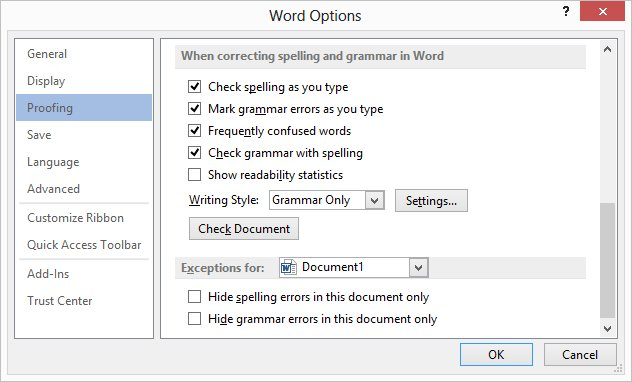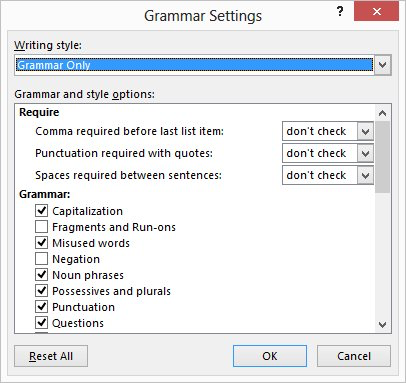Please Note: This article is written for users of the following Microsoft Word versions: 2007, 2010, and 2013. If you are using an earlier version (Word 2003 or earlier), this tip may not work for you. For a version of this tip written specifically for earlier versions of Word, click here: Checking for Incorrect Numbers in Text.
The grammar checker included with Word is quite powerful when it comes to checking matters of style in your writing. One of the things you can have Word check for is whether you are using numbers correctly in your text. Normally, any number ten or less should be spelled out (such as "nine trucks" or "three officers"). If the number is larger than ten, it should be expressed with numerals (as in "47 pencils" or "12 pennies").
By default, Word doesn't check for the correct use of numbers. You can change this feature of Word, however, by following these steps:

Figure 1. The Proofing options of the Word Options dialog box.

Figure 2. The Grammar Settings dialog box.
As with most other grammar-checking tools, you should not rely exclusively on this particular checking feature to correct all your incorrect usage. There are actually some pretty complex rules that writers and editors should follow when using numbers within text. For more information, refer to a good style guide, such as the Chicago Manual of Style.
WordTips is your source for cost-effective Microsoft Word training. (Microsoft Word is the most popular word processing software in the world.) This tip (7837) applies to Microsoft Word 2007, 2010, and 2013. You can find a version of this tip for the older menu interface of Word here: Checking for Incorrect Numbers in Text.

Comprehensive VBA Guide Visual Basic for Applications (VBA) is the language used for writing macros in all Office programs. This complete guide shows both professionals and novices how to master VBA in order to customize the entire Office suite for their needs. Check out Mastering VBA for Office 2010 today!
Word's grammar checker dutifully tries to mark all the questionable grammar in your sentences. If you are tired of a ...
Discover MoreWhen you have Word do grammar checking on your document, it typically marks everything it considers wrong with the way ...
Discover MoreNeed to check grammar using a macro? Word includes a couple of different ways to perform the check, and what you see ...
Discover MoreFREE SERVICE: Get tips like this every week in WordTips, a free productivity newsletter. Enter your address and click "Subscribe."
There are currently no comments for this tip. (Be the first to leave your comment—just use the simple form above!)
Got a version of Word that uses the ribbon interface (Word 2007 or later)? This site is for you! If you use an earlier version of Word, visit our WordTips site focusing on the menu interface.
Visit the WordTips channel on YouTube
FREE SERVICE: Get tips like this every week in WordTips, a free productivity newsletter. Enter your address and click "Subscribe."
Copyright © 2024 Sharon Parq Associates, Inc.
Comments